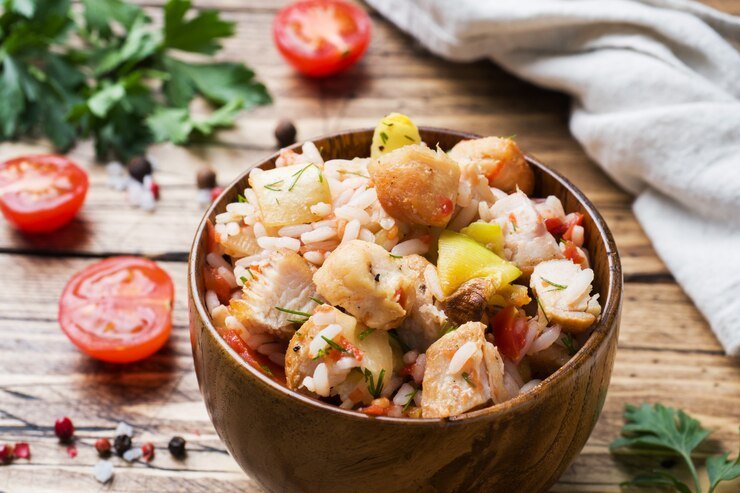Cultural Significance
Crab Salad as a Culinary Icon
Media Influence and Cultural Integration
Enduring Legacy
Today, Crab Salad remains a cherished dish, celebrated at food festivals and served with pride in restaurants and homes. It continues to be a symbol of the West Coast’s culinary innovation and its ability to stay relevant through changing tastes and times.
In the next section, we will address some of the most frequently asked questions about Crab Salad, shedding light on its enduring popularity and answering queries that seafood enthusiasts often ponder.
Serving and Presentation Tips
Elevating the Dining Experience
The presentation of Crab Salad can significantly enhance the dining experience, transforming it from a simple meal to an elegant feast. Here are some tips to elevate your Crab Salad presentation:
- Use a chilled plate to serve the salad, which helps keep the ingredients fresh and crisp during the dining experience.
- Arrange the components artistically on the plate. Layer the lettuce as a base, then neatly pile the crab meat, and strategically place the eggs and tomatoes around the dish for color and texture contrast.
- Garnish with fresh herbs like dill or parsley, which add a burst of color and a hint of fresh flavor that complements the crab perfectly.
These simple yet effective presentation techniques can turn the serving of Crab Salad into a visually appealing and appetizing event, sure to impress guests and elevate any dining occasion.
The Future of Crab Salad
Innovation and Trends
As culinary trends evolve, so does the interpretation and adaptation of traditional dishes like Crab Salad. Looking to the future, we see several potential trends influencing how this dish is prepared and enjoyed:
- Incorporation of exotic ingredients: Chefs might begin experimenting with ingredients like seaweed or pickled vegetables to add new flavors and textures to the traditional Crab Salad.
- Plant-based variations: With the rise of vegetarian and vegan diets, there might be an increase in demand for plant-based alternatives to crab meat, such as jackfruit or marinated artichoke hearts.
- Focus on sustainability: As sustainability becomes a more pressing concern, the choice of ingredients, particularly the type of crab used, will likely reflect more sustainable and ethical sourcing practices.
FAQs about Crab Salad
Common Questions and Answers
Crab Salad often stirs curiosity among culinary enthusiasts, prompting questions about its preparation, best practices, and variations. Here are some of the most commonly asked questions, providing deeper insights into this beloved dish:
What is the best type of crab to use for Crab Salad?
Dungeness crab is widely preferred for its sweet, tender meat, but jumbo lump crab meat or even blue crab can be excellent choices, depending on regional availability and personal taste preferences.
How can I make my Crab Salad healthier?
To lighten up the dish, consider substituting the traditional mayonnaise in the dressing with Greek yogurt or a light sour cream. Incorporating more greens like spinach or arugula can also boost the nutritional value.
Can Crab Salad be prepared in advance?
Yes, you can prepare Crab Salad in advance, but it’s best to add the dressing just before serving to maintain the freshness and crispness of the ingredients.
What are some good pairings with Crab Salad?
Crab Salad pairs wonderfully with a crisp white wine, fresh baguette, or a light soup, making it a versatile dish for various dining settings.
These answers not only help in preparing and serving Crab Salad but also enhance the enjoyment and appreciation of the dish, making each bite a true culinary delight
Recommended Internal Links
- Link: Dungeness Crab Legs
- Embed in: « Dungeness crab » in the section « Part 1: Introduction to Crab Salad » where it talks about the types of crab used in Crab Salad. This link will provide readers with more specific information on Dungeness crab, enhancing their understanding of why it’s a preferred choice for the salad.
- Link: Crab Salad Recipe
- Embed in: « Crab Salad » in the introduction paragraph where Crab Salad is first mentioned. This link will offer readers a direct recipe from the same website, creating a seamless navigation experience to actual Crab Salad recipes.
- Link: Spinach and Strawberry Salad
- Embed in: « contemporary palates » in Part 1 under the subheading « What is Crab Salad? » This can subtly suggest another salad option that caters to modern taste preferences, providing an alternative or complementary dish idea.
Additional Resources and Readings
Here are some informative external links that can be embedded into your article on Crab Salad to provide additional context and depth on the cultural significance of this dish on the West Coast:
- Link: Food Timeline – History Notes on Salad
- Embed in: « its story is a testament to how regional ingredients and inventive recipes can come together » in the introduction. This link provides a historical perspective on salads in general, which can enrich the understanding of how Crab Salad fits into broader culinary traditions.
- Link: Food Timeline – History Notes on Fish & Shellfish
- Embed in: « Known for its simplicity and versatility, it has become a beloved choice across America » in the conclusion. This link offers a detailed history of seafood consumption which complements the discussion on Crab Salad’s origins and its use of crab meat.
- Link: Gastronomy – Britannica
- Embed in: « It serves as a cultural artifact, a testament to the history and ongoing evolution of West Coast cuisine » in the conclusion. This Britannica article explores the relationship between food, culture, and tradition, providing a scholarly background that supports the article’s themes of culinary innovation and cultural significance.
These links are selected to provide readers with a richer context and deeper understanding of the culinary and cultural aspects of Crab Salad without directing them to direct competitors or recipe providers.



